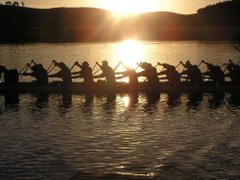
IT'S NOT HOW SMART YOU ARE, IT'S HOW YOU ARE SMART!
Howard Gardner's Theory of Multiple Intelligences
What parent can not see gleaming rays of genius in their child? And yet, how many children come to school and demonstrate their own unique genius? There was a time when it might have been a joke to suggest "Every parent thinks their kid's a genius." But research on human intelligence is suggesting that the joke may be on educators! There is a constant flow of new information on how the human brain operates, how it differs in function between genders, how emotions impact on intellectual acuity, even on how genetics and environment each impact our childrens' cognitive abilities. While each area of study has its merits, Howard Gardner of Harvard University has identified different KINDS of intelligence we possess. This has particularly strong ramifications in the classroom, because if we can identify children's different strengths among these intelligences, we can accommodate different children more successfully according to their orientation to learning.
Thus far Gardner 's work suggests nine intelligences. He speculates that there may be many more yet to be identified. Time will tell. These are the paths to children's learning teachers can address in their classrooms right now. They are:
VISUAL/SPATIAL - learning visually and organizing ideas spatially. Seeing concepts in action in order to understand them. The ability to "see" things in one's mind in planning to create a product or solve a problem.
VERBAL/LINGUISTIC - learning through the spoken and written word. This intelligence was always valued in the traditional classroom and in traditional assessments of intelligence and achievement.
MATHEMATICAL/LOGICAL - learning through reasoning and problem solving. Also highly valued in the traditional classroom, where students were asked to adapt to logically sequenced delivery of instruction.
BODILY/KINESTHETIC - learning through interaction with one's environment. This intelligence is not the domain of "overly active" learners. It promotes understanding through concrete experience.
MUSICAL/RHYTHMIC - learning through patterns, rhythms and music. This includes not only auditory learning, but the identification of patterns through all the senses.
INTRAPERSONAL - learning through feelings, values and attitudes. This is a decidedly affective component of learning through which students place value on what they learn and take ownership for their learning.
INTERPERSONAL - learning through interaction with others. Not the domain of children who are simply "talkative" or "overly social." This intelligence promotes collaboration and working cooperatively with others.
NATURALIST - learning through classification, categories and hierarchies. The naturalist intelligence picks up on subtle differences in meaning. It is not simply the study of nature; it can be used in all areas of study..
EXISTENTIAL - learning by seeing the "big picture": "Why are we here?" "What is my role in the world?" "What is my place in my family, school and community?" This intelligence seeks connections to real world understandings and applications of new learning.
Teachers are now working on assimilating this knowledge into their strategies for helping children learn. While it is too early to tell all the ramifications for this research, it is clear that the day is past where educators teach the text book and it is the dawn of educators teaching each child according to their orientation to the world.
My Thoughts:
I am a big fan of Gardner. Gardner acknowledges that there is more to intelligence and learning than mainstream education models, with a strong focus on the 3 R's - reading, 'riting and 'rithmetic!!
In primary school I was always advanced for my age in my vocabulary and spelling. I make sense of difficult concepts through talking about them. So it is not surprising that my main intelligence is linguistic, and I am a linguistic learner. This leads me to wonder if this is always the case - is everybody smart in the area that suits their learning style? Or do you get fantastic mathematicians who prefer to learn linguistically? Well, I do know that everybody has all of these intelligences to varying degrees, so I suspect that everyone can learn in these areas to varying degrees also.
Another point to consider is this - I am intelligent linguistically, however my logic skills are not so strong. If I were to compare myself to a person with high logicistic skills and lower linguistic skills, who would be smarter? Can you really judge? I don't think so. So this begs the question, why should a teacher's method of education favour any particular area of intelligence? What would happen if a maths teacher, who is accustomed to teaching from a logical perspective, decided to do some activities that required naturalist, kinaesthetic and interpersonal skills?
What would happen is that every member of the class would probably find the subject of maths a lot more interesting, and achievable. The class member who struggles to comprehend graphs and data tables but loves working with their hands all of a sudden finds that the penny drops when they actually create a graph using concrete objects. By catering for all learning styles in a lesson, the teacher engages every student in the lesson in a manner that is relevant to them.

